Spatial Pattern of Soil Erosion Drivers and the Contribution Rate of Human Activities on the Loess Plateau from 2000 to 2015: A Boundary Line from Northeast to Southwest
Abstract
:1. Introduction
2. Materials and Methods
2.1. Study Area
2.2. Data and Materials
2.3. Methods
2.3.1. Soil Erosion Modulus Simulation
- (1)
- Rainfall Erosivity Factor (R)
- (2)
- Soil Erodibility Factor (K)
- (3)
- Slope Length (L) and Slope Factor (S)
- (4)
- Vegetation Cover and Management Factor (C)
2.3.2. Statistical Analysis
2.3.3. Soil Erosion Modulus Simulation under Meteorological Conditions
2.3.4. Determination of the Contribution Rate of Human Activities
3. Results
3.1. Spatial and Temporal Characteristics of Soil Erosion
3.1.1. Spatial Distribution Characteristics
3.1.2. Spatiotemporal Variation of Soil Erosion
3.1.3. Accuracy Verification
3.2. Driving Mechanism and Contribution Rate of Human Activities
3.2.1. Response Mechanism of Soil Erosion Change to VFC and Precipitation
3.2.2. Contribution Rate of Human Activities
4. Discussion
4.1. Spatial Differentiation of the Soil Erosion Driving Mechanism and the Contribution Rate of Human Activities
4.1.1. Demarcation Line of the Driving Mechanism
4.1.2. Demarcation Line of Human Activities Contribution Rate
4.1.3. Regional Characteristics of Soil Erosion Control on the Loess Plateau under the Combined Influence of Human and Climate
4.2. Deficiencies and Prospects in Soil-Erosion Research
5. Conclusions
Author Contributions
Funding
Acknowledgments
Conflicts of Interest
References
- Liu, B.Y.; Yang, Y.; Lu, S.J. Discriminations on common soil erosion terms and their implications for soil and water conservation. Sci. Soil Water Conserv. 2018, 16, 9–16. [Google Scholar] [CrossRef]
- Zhu, X.M.; Ren, M.E. Formation process and amelioration of the loess plateau in China. Chin. J. Popul. Resour. Environ. 1992, 1, 7–14. [Google Scholar] [CrossRef]
- Guo, J.Y. Research on the causes of collapsibility. Hydrogeol. Eng. Geol. 1958, 4, 9–13. [Google Scholar] [CrossRef]
- Guo, Y.W.; Kato, M. Discussion on the mechanism of loess collapsibility caused by irrigation from the aggregates stability-losing angle. J. Lanzhou Univ. 2007, 43, 6–10. [Google Scholar] [CrossRef]
- Shi, H.; Shao, M.A. Soil and water loss from the loess plateau in China. J. Arid Environ. 2000, 45, 9–20. [Google Scholar] [CrossRef]
- Chaplot, V.A.M.; Rumpel, C.; Valentin, C. Water erosion impact on soil and carbon redistributions within uplands of Mekong River. Glob. Biogeochem. Cycles 2005, 19. [Google Scholar] [CrossRef]
- Loughran, R.J.; Elliott, G.L.; Mcfarlane, D.J.; Campbell, B.L. A Survey of Soil Erosion in Australia using Caesium-137. Geogr. Res. 2010, 42, 221–233. [Google Scholar] [CrossRef]
- Foucher, A.; Salvador-Blanes, S.; Evrard, O.; Simonneau, A.; Chapron, E.; Courp, T.; Cerdan, O.; Lefèvre, L.; Adriaensen, H.; Lecompte, F.; et al. Increase in soil erosion after agricultural intensification: Evidence from a lowland basin in France. Anthropocene 2014, 7, 30–41. [Google Scholar] [CrossRef] [Green Version]
- Le Bissonnais, Y.; Montier, C.; Jamagne, M.; Daroussin, J.; King, D. Mapping erosion risk for cultivated soil in France. Catena 2002, 46, 207–220. [Google Scholar] [CrossRef]
- Li, Z.W.; Liu, C.; Dong, Y.T.; Chang, X.F.; Nie, X.D.; Liu, L.; Xiao, H.B.; Lu, Y.M.; Zeng, G.M. Response of soil organic carbon and nitrogen stocks to soil erosion and land use types in the loess hilly-gully region of China. Soil Tillage Res. 2017, 166, 1–9. [Google Scholar] [CrossRef]
- De Vente, J.; Poesen, J.; Verstraeten, G.; Govers, G.; Vanmaercke, M.; Van Rompaey, A.; Arabkhedri, M.; Boix-Fayos, C. Predicting soil erosion and sediment yield at regional scales: Where do we stand? Earth-Sci. Rev. 2013, 127, 16–29. [Google Scholar] [CrossRef]
- Fu, B.J. Soil erosion and its control in the loess plateau of China. Soil Use Manag. 1989, 5, 76–82. [Google Scholar] [CrossRef]
- Li, J.X.; Liu, Q.L.; Feng, X.M.; Shi, W.Y.; Fu, B.J.; Lv, Y.H.; Liu, Y. The synergistic effects of afforestation and the construction of check-dams on sediment trapping: Four decades of evolution on the Loess Plateau, China. Land Degrad. Dev. 2018, 30, 622–635. [Google Scholar] [CrossRef]
- Zhao, G.J.; Mu, X.M.; Jiao, J.Y.; An, Z.F.; Klik, A.; Wang, F.; Jiao, F.; Yue, X.L.; Peng, G.; Sun, W.Y. Evidence and causes of spatiotemporal changes in runoff and sediment yield on the Chinese Loess plateau. Land Degrad. Dev. 2016. [Google Scholar] [CrossRef]
- Fu, B.J.; Liu, Y.; Lv, Y.H.; He, C.S.; Zeng, Y.; Wu, B.F. Assessing the soil erosion control service of ecosystems change in the loess plateau of China. Ecol. Complex. 2011, 8, 284–293. [Google Scholar] [CrossRef]
- He, X.; Zhou, J.; Zhang, X.; Tang, K. Soil erosion response to climatic change and human activity during the quaternary on the loess plateau, China. Reg. Environ. Chang. 2006, 6, 62–70. [Google Scholar] [CrossRef]
- Fu, B.J.; Wang, Y.F.; Lv, Y.H.; He, C.S.; Chen, L.D.; Song, C.J. The effects of land-use combinations on soil erosion: A case study in the loess plateau of China. Prog. Phys. Geogr. 2009, 33, 793–804. [Google Scholar] [CrossRef]
- Zhao, G.; Mu, X.; Wen, Z.; Wang, F.; Gao, P. Soil erosion, conservation, and eco-environment changes in the loess plateau of China. Land Degrad. Dev. 2013, 24, 499–510. [Google Scholar] [CrossRef]
- Wei, Y.H.; He, Z.; Jiao, J.Y.; Li, Y.J.; Chen, Y.X.; Zhao, H.K. Variation in the sediment deposition behind check-dams under different soil erosion conditions on the Loess Plateau, China: Sediment deposition behind check-dams in different erosion conditions. Earth Surf. Process. Landf. 2018, 43. [Google Scholar] [CrossRef]
- Sun, L.; Zhang, G.H.; Wang, B.; Luan, L.L. Soil erosion resistance of black locust land with different ages of returning farmland on Loess Plateau. Trans. Chin. Soc. Agric. Eng. 2017, 33, 191–197. [Google Scholar] [CrossRef]
- Yu, K.K.; Xu, H.; Lan, J.H.; Sheng, E.G.; Liu, B.; Wu, H.X.; Tan, L.C.; Yeager, K.M. Climate change and soil erosion in a small alpine lake basin on the Loess Plateau, China. Earth Surf. Process. Landf. 2017, 8, 1238–1247. [Google Scholar] [CrossRef]
- The China Meteorological Data Service Center. Daily Data Set of Surface Climate in China (V3.0). Available online: http://cdc.cma.gov.cn (accessed on 7 April 2019).
- Wischmeier, W.H.; Smith, D.D. Predicting Rainfall Erosion Losses: A Guide to Conservation Planning [USA]; Agriculture Handbook No. 537; United States. Dept. of Agriculture: Wanshington, DC, USA, 1978; p. 537.
- Renard, K.G.; Foster, G.R.; Weesies, G.A.; Mccool, D.K.; Yoder, D.C. Predicting Soil Erosion by Water: A Guide to Conservation Planning with the Revised Universal Soil Loss Equation (RUSLE); Agricultural Handbook: No. 703; United States. Dept. of Agriculture: Washington, DC, USA, 1997.
- Lu, D.; Li, G.; Valladares, G.S.; Batistella, M. Mapping soil erosion risk in Rondônia, Brazilian Amazonia: Using RUSLE, remote sensing and GIS. Land Degrad. Dev. 2004, 15, 499–512. [Google Scholar] [CrossRef]
- Zhang, W.B.; Xie, Y.; Liu, B.Y. Estimation of rainfall erosivity using rainfall amount and rainfall intensity. Geogr. Res. 2002, 21, 384–390. [Google Scholar] [CrossRef]
- Williams, J.R. The erosion-productivity impact calculator (EPIC) model: A case history. Philos. Trans. B 1990, 329, 421–428. [Google Scholar] [CrossRef]
- Ministry of Ecology and Environment of the People’s Republic of China; National Development and Reform Commission. Ecological Protection Red Line Delineation Guide 2017; Document No. 48; Ministry of Ecology and Environment of the People’s Republic of China: Beijing, China; National Development and Reform Commission: Beijing, China, 2017.
- Mccool, D.K.; Foster, G.R.; Mutchler, C.K.; Meyer, L.D. Revised slope length factor for the universal soil loss equation. Trans. ASAE 1989, 30, 1387–1396. [Google Scholar] [CrossRef]
- Liu, B.Y.; Xie, Y.; Zhang, K.L. Prediction Model of Soil Erosion; Science and Technology of China Press: Beijing, China, 2001. [Google Scholar]
- Cai, C.F.; Ding, S.W.; Shi, Z.H.; Huang, L.; Zhang, Y.G. Study of applying USLE and Geographical Information System IDRISI to predict soil Erosion in small watershed. J. Soil Water Conserv. 2000, 14, 20–24. [Google Scholar] [CrossRef]
- Shobairi, S.O.; Li, M.Y. Dynamic Modelling of VFC from 2000 to 2010 Using NDVI and DMSP/OLS Time Series: A Study in Guangdong Province, China. J. Geogr. Inf. Syst. 2016, 8, 205–223. [Google Scholar] [CrossRef] [Green Version]
- Tang, Y.Z.; Shao, Q.Q.; Liu, J.Y.; Zhang, H.Y.; Yang, F.; Cao, W.; Wu, D.; Gong, G.L. Did Ecological Restoration Hit Its Mark? Monitoring and Assessing Ecological Changes in the Grain for Green Program Region Using Multi-Source Satellite Images. Remote Sens. 2019, 11, 358. [Google Scholar] [CrossRef]
- Ming, D.X. Field Trials and Statistical Analysis; Science Press: Beijing, China, 2008. [Google Scholar]
- Woodward, F.I.; Smith, T.M. Global Photosynthesis and Stomatal Conductance: Modelling the Controls by Soil and Climate. Adv. Bot. Res. 1994, 20. [Google Scholar] [CrossRef]
- Allen, R.G.; Pereira, L.S.; Raes, D.; Smith, M. Crop Evapotranspiration—Guidelines for Computing Crop Water Requirements—FAO Irrigation and Drainage Paper No. 56; FAO: Rome, Italy, 1998; p. 300. [Google Scholar] [CrossRef]
- Sun, W.Y.; Shao, Q.Q.; Liu, J.Y. Soil erosion and its response to the changes of precipitation and vegetation cover on the Loess plateau. J. Geogr. Sci. 2013, 23, 1091–1106. [Google Scholar] [CrossRef]
- Qin, W.; Guo, Q.K.; Cao, W.H.; Yin, Z.; Yan, Q.H.; Shan, Z.J.; Zheng, F.L. A new RUSLE slope length factor and its application to soil erosion assessment in a loess plateau watershed. Soil Tillage Res. 2018, 182, 10–24. [Google Scholar] [CrossRef]
- Tang, Q.; Xu, Y.; Bennett, S.J.; Li, Y. Assessment of soil erosion using RUSLE and GIS: A case study of the Yangou watershed in the Loess plateau, China. Environ. Earth Sci. 2015, 73, 1715–1724. [Google Scholar] [CrossRef]
- Qin, W.; Zhu, Q.; Zhang, Y. Soil erosion assessment of small watershed in loess plateau based on GIS and RUSLE. Trans. Chin. Soc. Agric. Eng. 2009, 25, 157–163. [Google Scholar] [CrossRef]
- Nearing, M.A.; Jetten, V.; Baffaut, C.; Cerdan, O.; Couturier, A.; Hernandez, M.; Le Bissonnais, Y.; Nichols, M.H.; Nunes, J.P.; Renschler, C.S.; et al. Modeling response of soil erosion and runoff to changes in precipitation and cover. Catena 2005, 61, 131–154. [Google Scholar] [CrossRef]
- Zhou, P.; Luukkanen, O.; Tokola, T.; Nieminen, J. Effect of vegetation cover on soil erosion in a mountainous watershed. Catena 2008, 75, 319–325. [Google Scholar] [CrossRef]
- Zheng, J.Y.; Yin, Y.H.; Li, B.Y. A new scheme for climate regionalization in China. Acta Geogr. Sin. 2010, 65, 3–12. [Google Scholar] [CrossRef]
- Du, J.Q.; Shu, J.M.; Zhang, L.B.; Guo, Y. Responses of vegetation to climate change in the headwaters of China’s Yellow River Basin based on zoning of dry and wet climate. Chin. J. Plant Ecol. 2011, 35, 1192–1201. [Google Scholar] [CrossRef]
- Hu, H.Y. Essays on China’s population distribution. Acta Geogr. Sin. 1935, 2, 33–74. [Google Scholar]
- Jiao, Q.; Rui, L.; Wang, F.; Mu, X.; Li, P.F.; An, C.C. Impacts of re-vegetation on surface soil moisture over the chinese loess plateau based on remote sensing datasets. Remote Sens. 2016, 8, 156. [Google Scholar] [CrossRef]
- Wang, Z.L.; Shao, M.A.; Chang, Q.R. Effects of Rainfall Factors on Soil Erosion in Loess Plateau. J. Northwest Agric. Univ. 1998, 26, 101–105. [Google Scholar]
- Wu, X.Q.; Zhao, H.Y.; Liu, X.D.; Han, B. Evaluation on role of forest litter to water source conservation and soil and water conservation. J. Soil Eros Soil Water Conserv. 1998, 4, 24–28. [Google Scholar] [CrossRef]
- Vaezi, A.R.; Ahmadi, M.; Cerdà, A. Contribution of raindrop impact to the change of soil physical properties and water erosion under semi-arid rainfalls. Sci. Total Environ. 2017, 583, 382–392. [Google Scholar] [CrossRef] [PubMed]
- Kalnay, E.; Cai, M. Impact of urbanization and land-use change on climate. Nature 2003, 423, 528–531. [Google Scholar] [CrossRef] [PubMed]
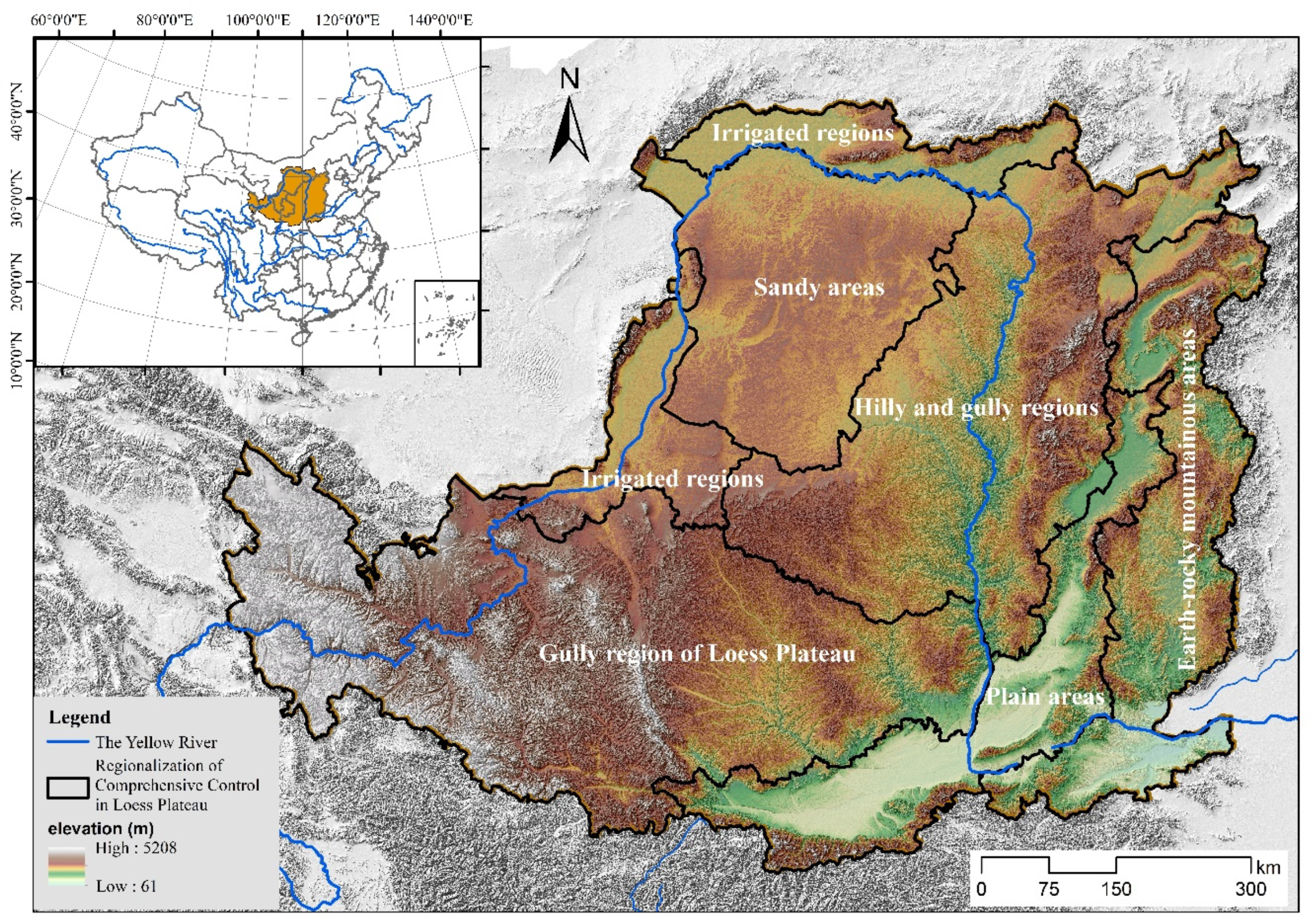
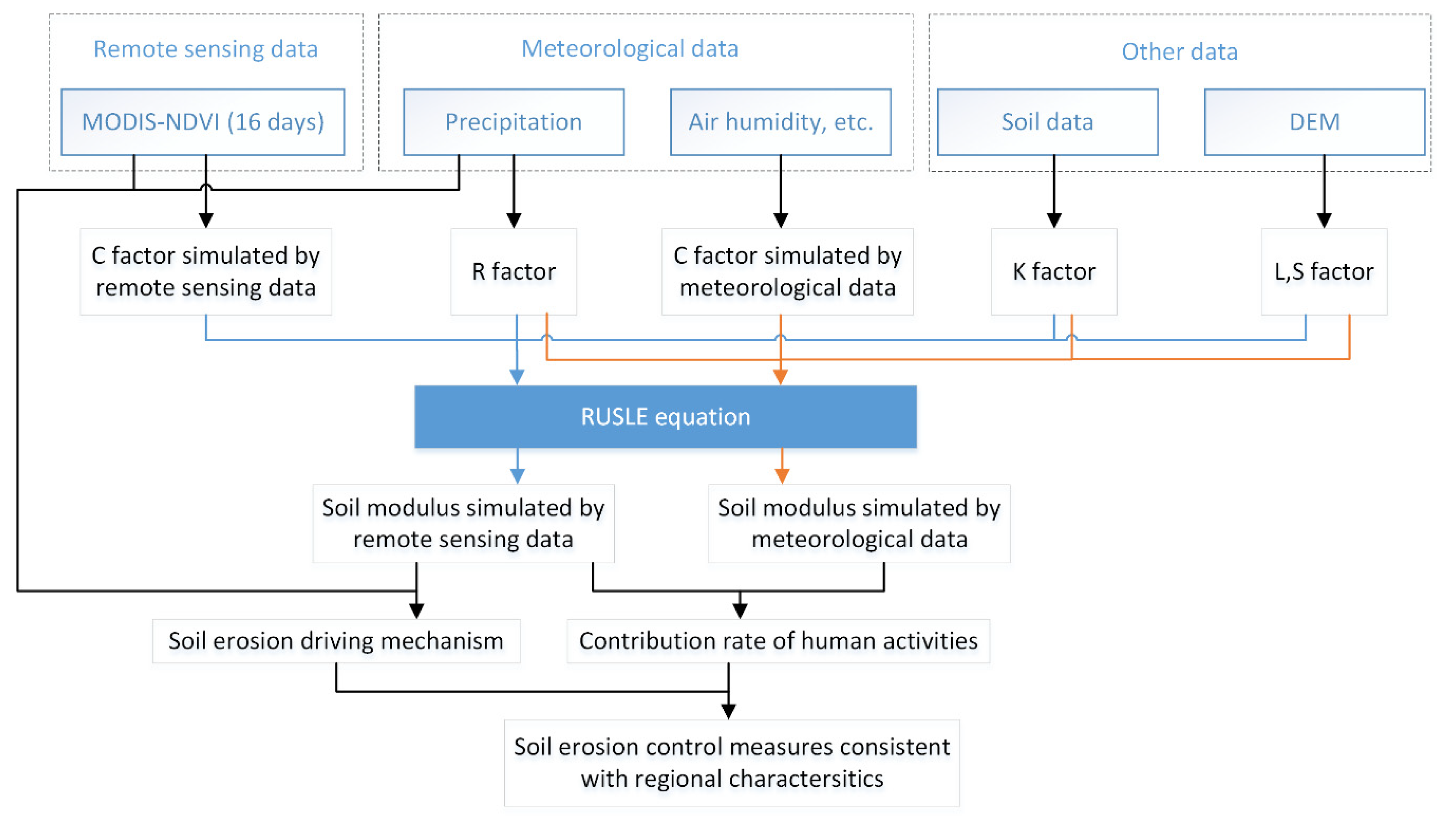
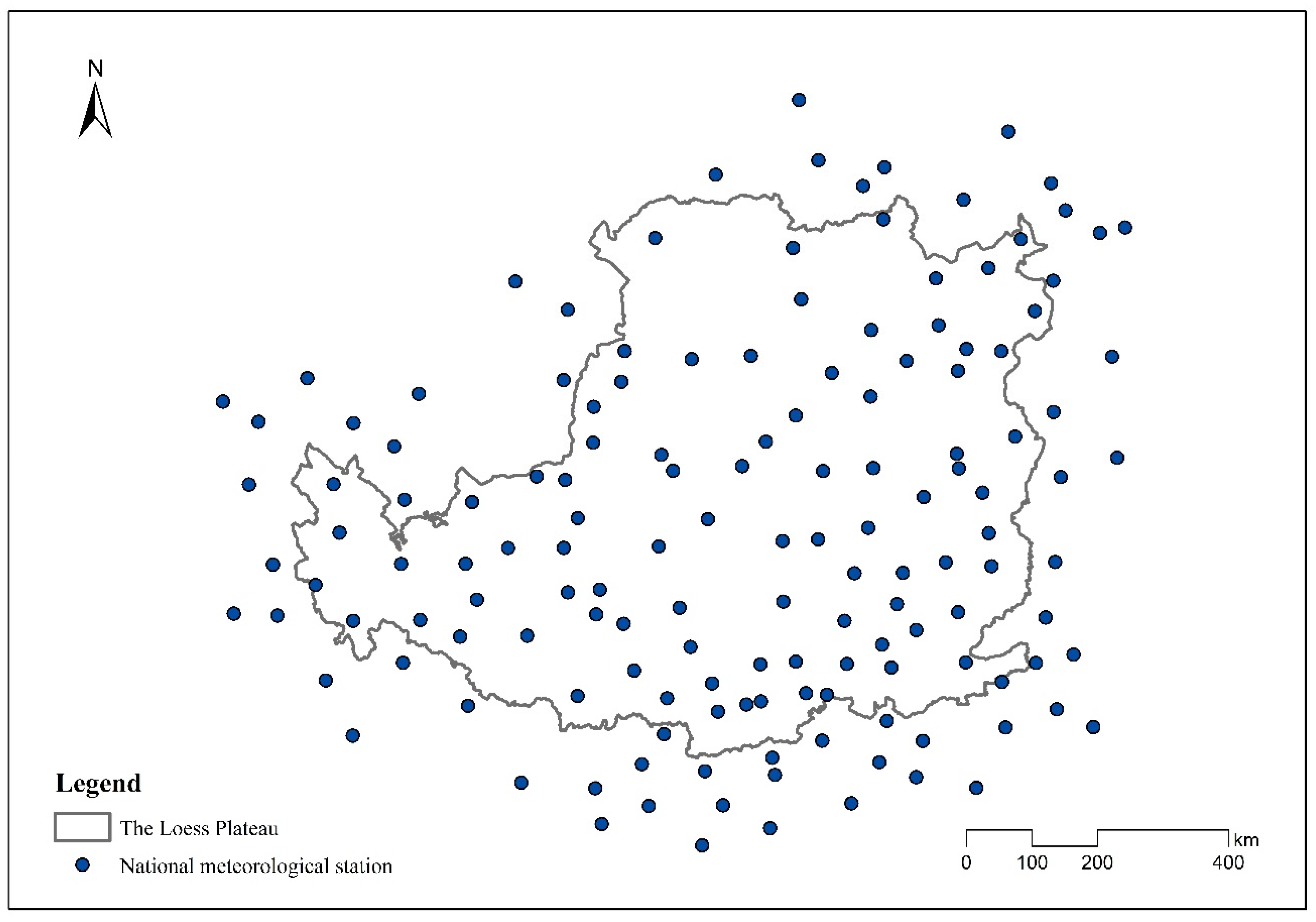
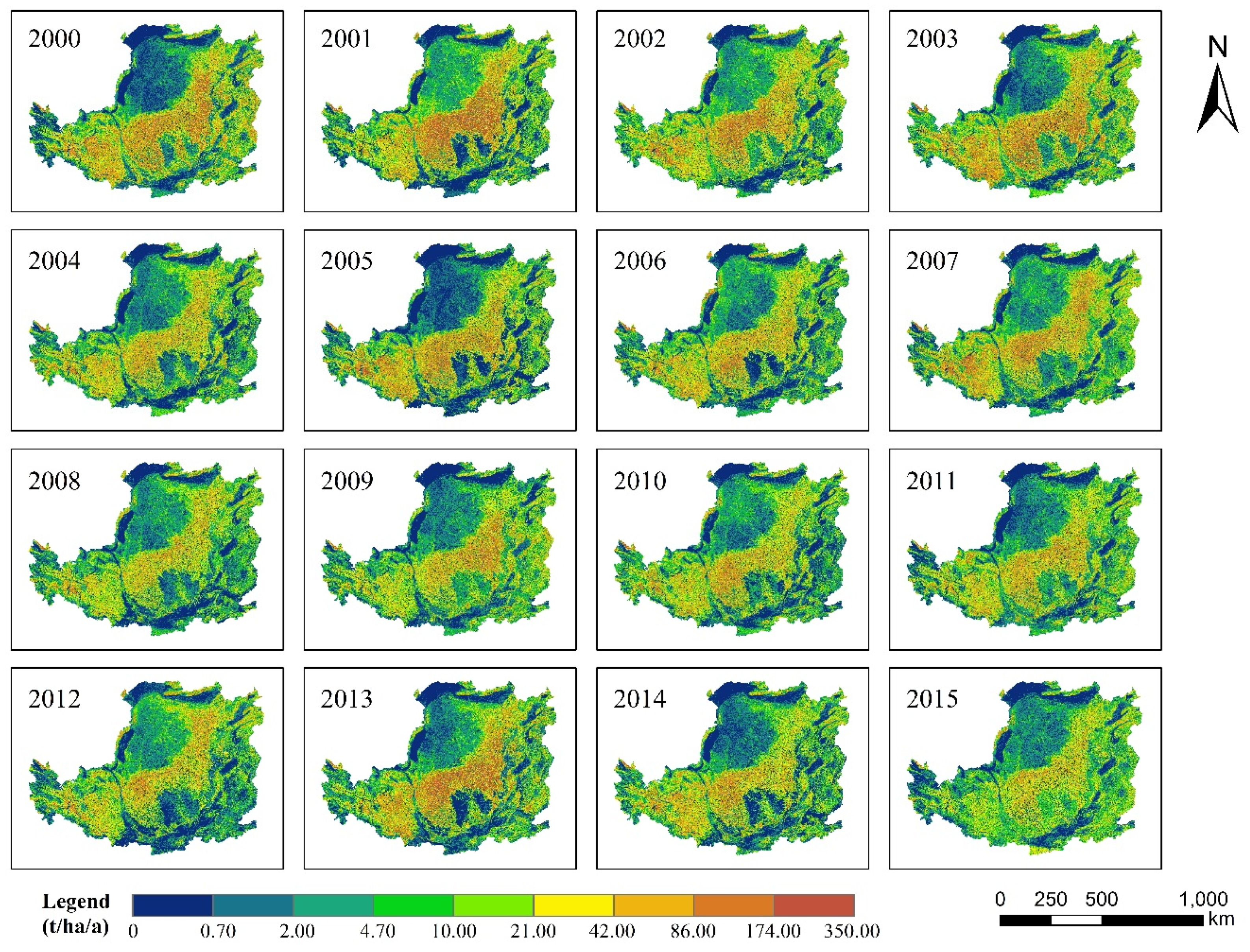
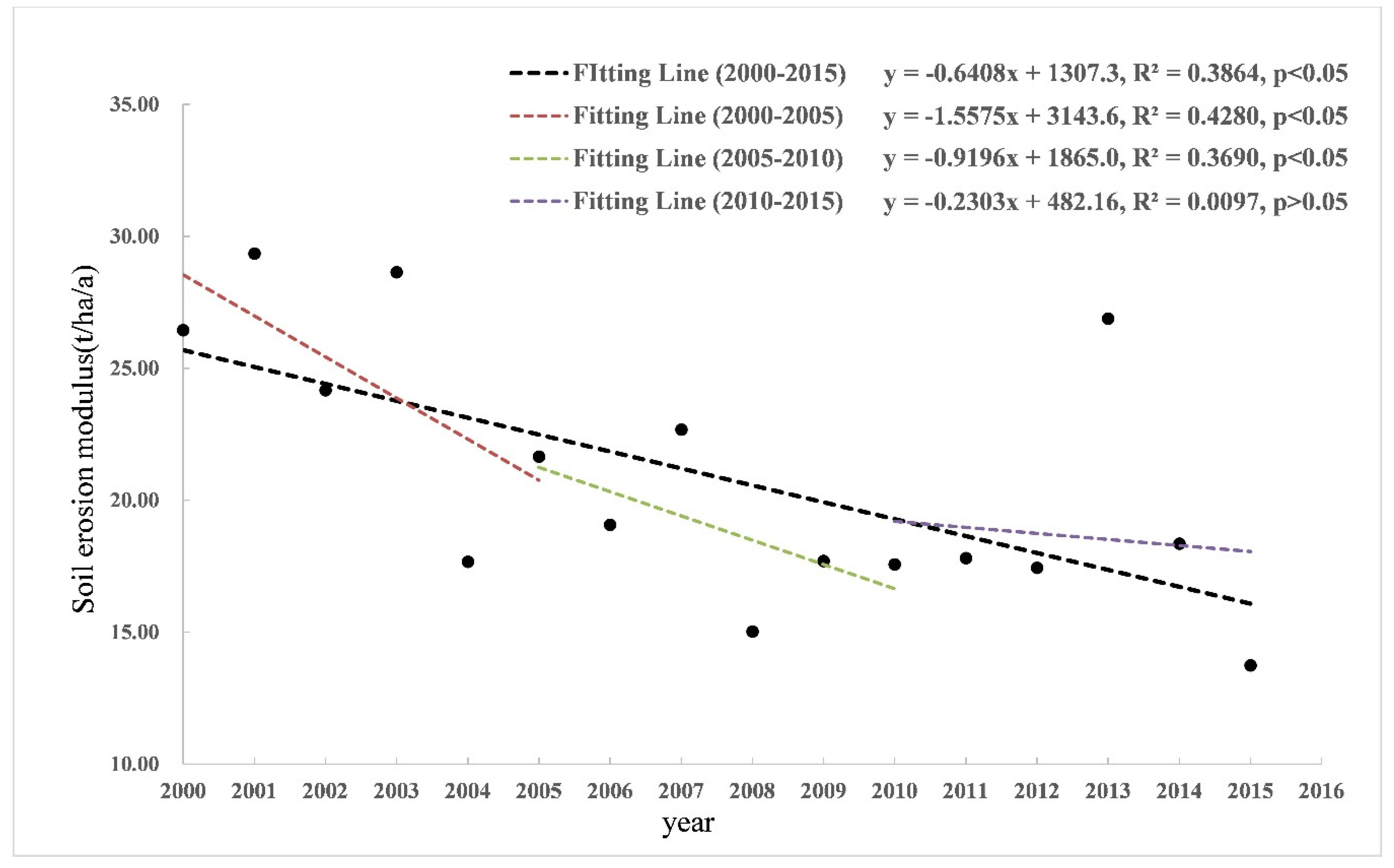

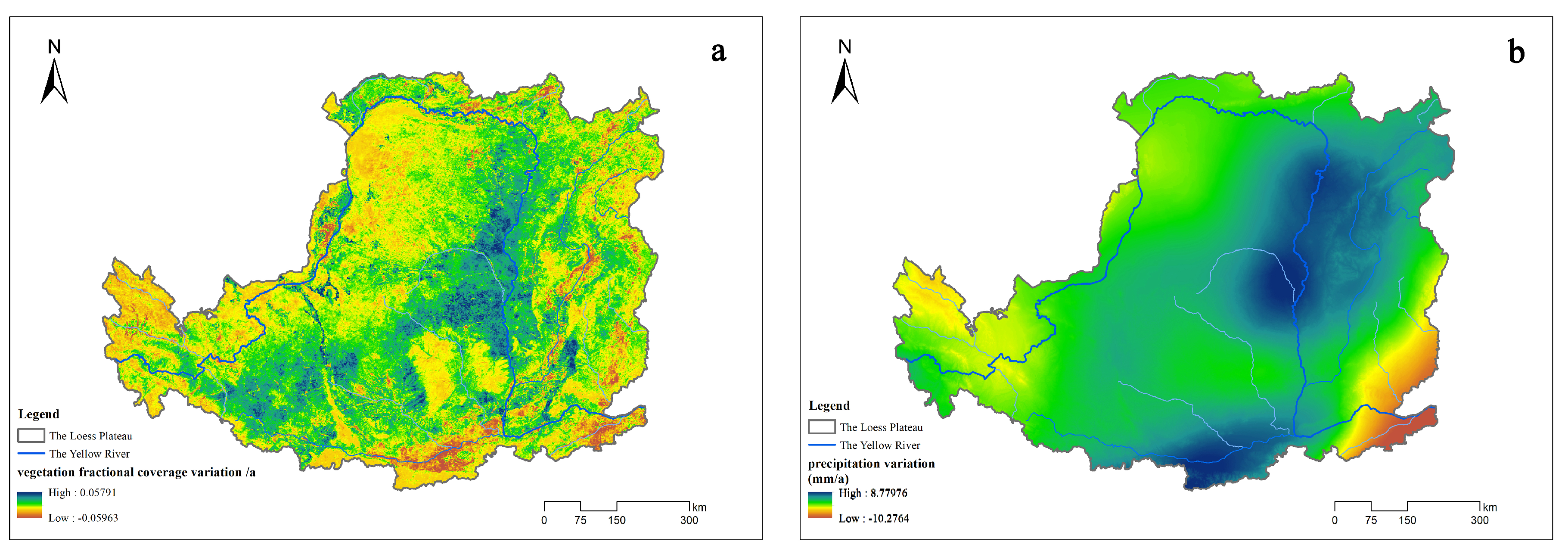
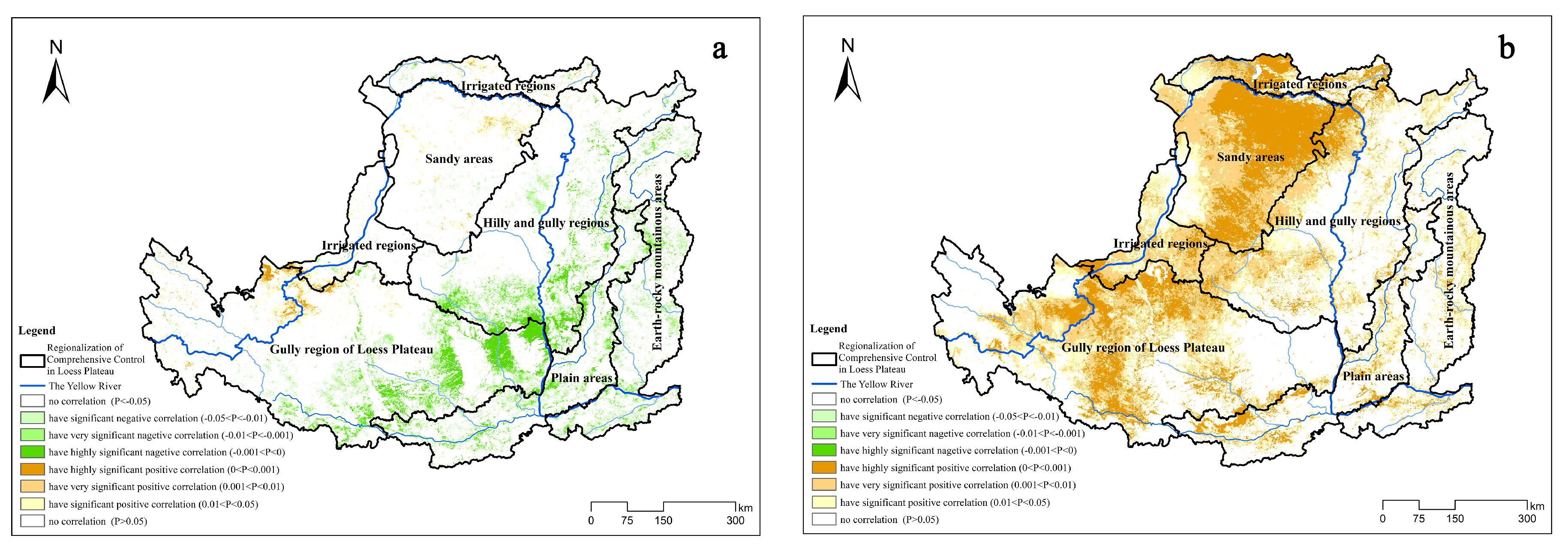

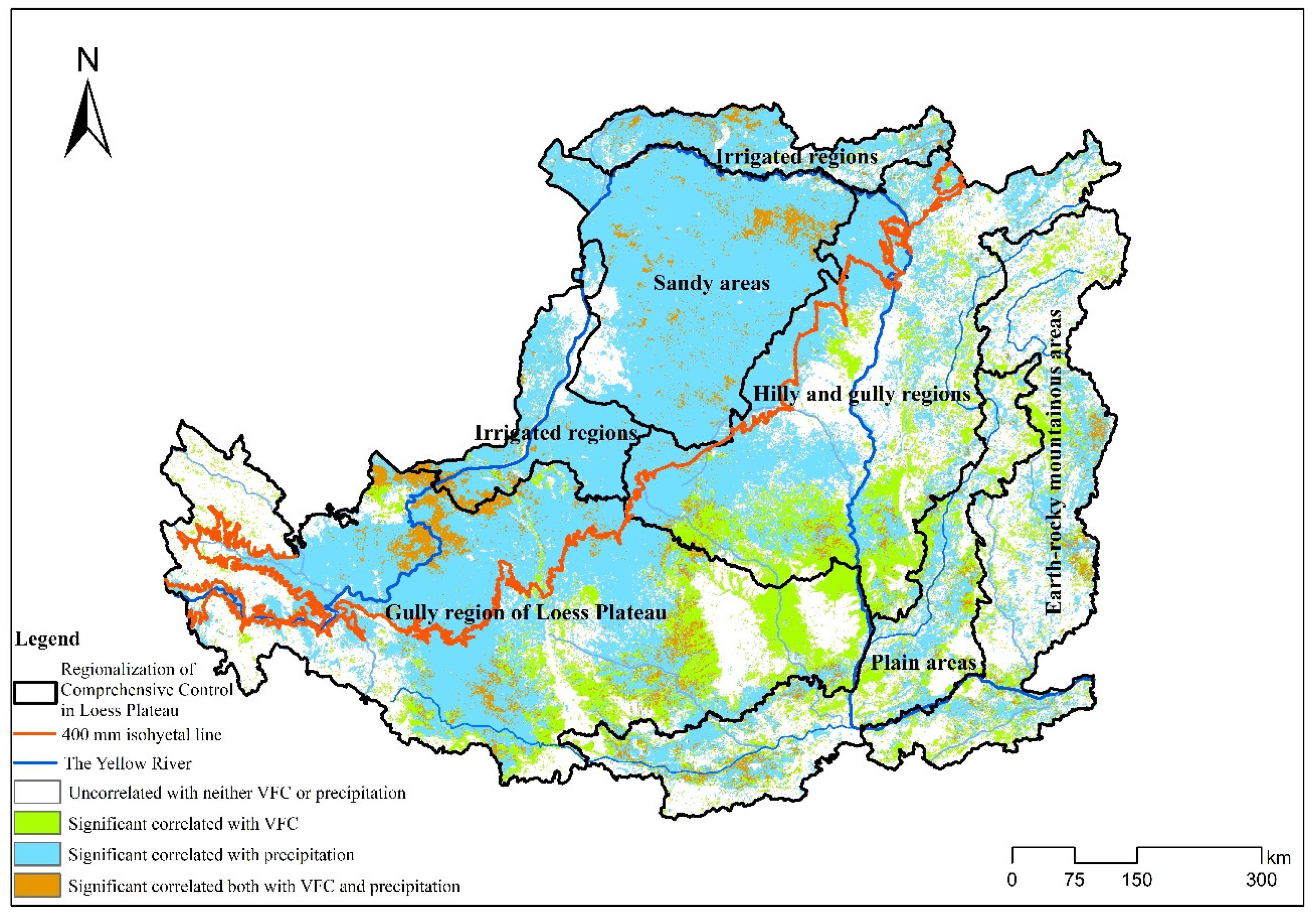


| Regionalization of Comprehensive Control | Irrigated Regions | Sandy Areas | Hilly and Gully Regions | Gully region of Loess Plateau | Earth-Rocky Mountainous Areas | Plain Areas | Total Loess Plateau |
|---|---|---|---|---|---|---|---|
| Annual average soil erosion modulus (t/ha/a) | 9.1908 | 4.2182 | 32.6789 | 28.5799 | 13.7850 | 11.3666 | 20.8856 |
| Area | Year | Annual Soil Erosion Modulus (t/ha/a) | Annual Soil Erosion Modulus in the Same Area (Year) (t/ha/a) | References |
|---|---|---|---|---|
| Yangou in the Loess Plateau | 1997–2006 | 13,4.6000 | 41.9038 (2000–2006) | Tang, Xu, Bennett, & Li, 2015. [39] |
| Simianyaogou in the Loess Plateau | 1971–2004 | 43.9979 | 101.1177 (2000–2004) | Qin, Zhu, & Zhang, 2009. [40] |
| The Loess Plateau | 2000–2010 | 15.2000 | 21.8140 (2000–2010) | Sun, Shao, & Liu, 2013. [37] |
| Lvergou in the Loess Plateau | 1993–2013 | 18.8900 | 18.3016 (2000–2013) | Qin, et al., 2018. [38] |
| Regionalization of Comprehensive Control | Irrigated Regions | Sandy Areas | Hilly and Gully Regions | Gully Region of Loess Plateau | Earth-Rocky Mountainous Areas | Plain Areas | Total Loess Plateau |
|---|---|---|---|---|---|---|---|
| 1 | −1.2717 | −4.9807 | −0.5513 | −0.7805 | 0.2345 | 0.3929 | −1.0774 |
| Sum of Squares | df | Mean Square | F | Sig. | |
|---|---|---|---|---|---|
| Between Groups | 2415.11 | 1 | 2415.11 | 21.43 | 0.0000037 |
| Within Groups | 1399184.26 | 12418 | 112.67 | ||
| Total | 1401599.37 | 12419 |
© 2019 by the authors. Licensee MDPI, Basel, Switzerland. This article is an open access article distributed under the terms and conditions of the Creative Commons Attribution (CC BY) license (http://creativecommons.org/licenses/by/4.0/).
Share and Cite
Guo, X.; Shao, Q. Spatial Pattern of Soil Erosion Drivers and the Contribution Rate of Human Activities on the Loess Plateau from 2000 to 2015: A Boundary Line from Northeast to Southwest. Remote Sens. 2019, 11, 2429. https://doi.org/10.3390/rs11202429
Guo X, Shao Q. Spatial Pattern of Soil Erosion Drivers and the Contribution Rate of Human Activities on the Loess Plateau from 2000 to 2015: A Boundary Line from Northeast to Southwest. Remote Sensing. 2019; 11(20):2429. https://doi.org/10.3390/rs11202429
Chicago/Turabian StyleGuo, Xingjian, and Quanqin Shao. 2019. "Spatial Pattern of Soil Erosion Drivers and the Contribution Rate of Human Activities on the Loess Plateau from 2000 to 2015: A Boundary Line from Northeast to Southwest" Remote Sensing 11, no. 20: 2429. https://doi.org/10.3390/rs11202429







